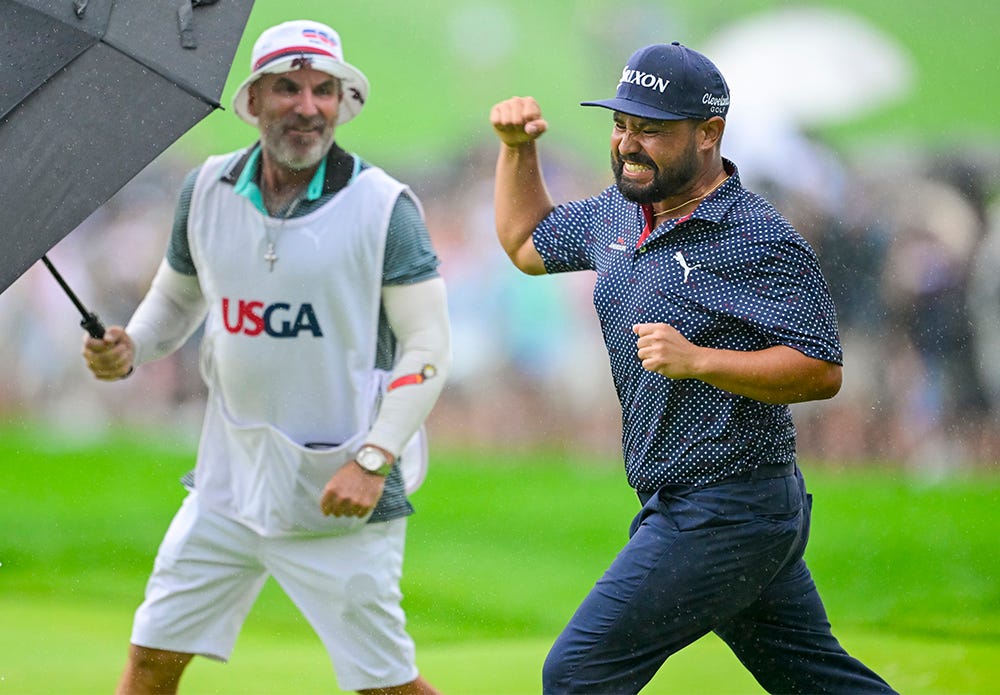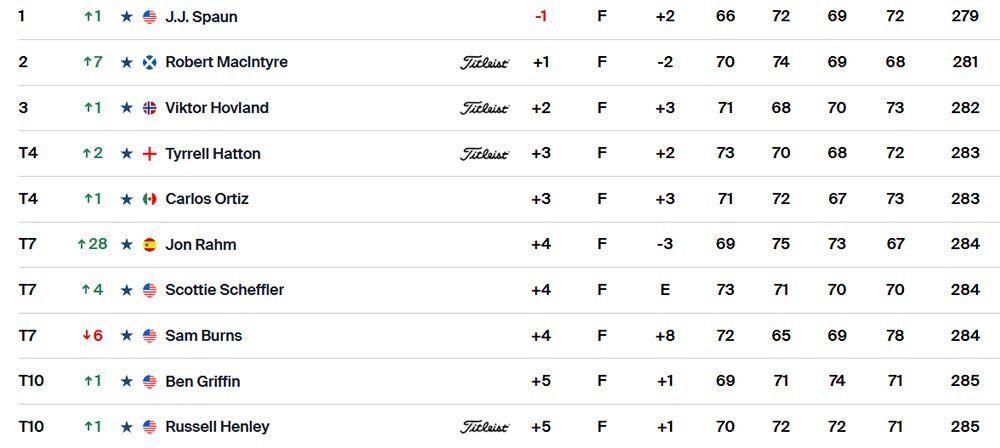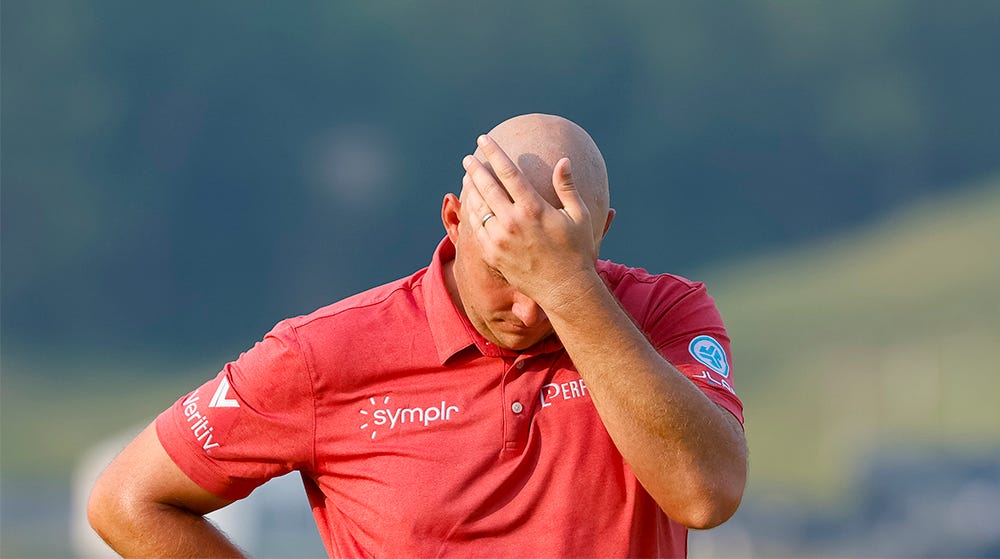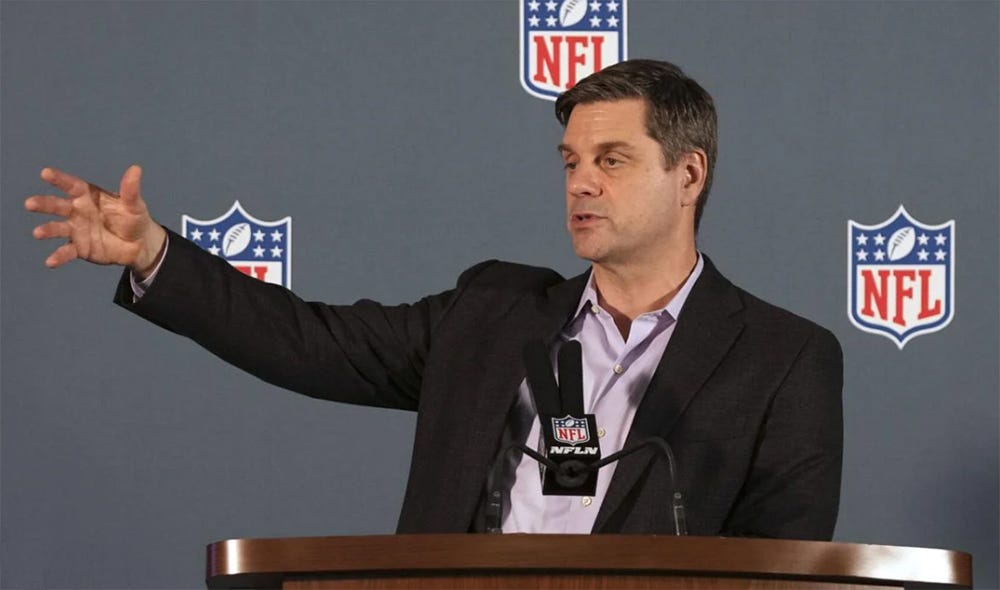Steely Spaun won't be denied at Oakmont
Incredible 64-foot putt caps U.S. Open rally; Tour to tap NFL's Rolapp as CEO
J.J. Spaun earns his major championship with a birdie-birdie finish for the ages (Chris Keane/USGA)
OAKMONT, Pa. — J.J. Spaun wielded his L.A.B. putter like a magic wand all week at Oakmont Country Club. It started on Thursday with the only bogey-free round (66) of the U.S. Open, and 72 hours later he closed one of the wildest Sundays in the 125 editions of the national championship with an improbable, 64-foot, cross-country birdie putt on the 72nd green.
The 34-year-old Southern Californian, with just one previous PGA Tour victory, rolled in the major-winner to beat Scotland’s Robert MacIntyre by two strokes. Spaun, a former San Diego State walk-on, posted a final-round 2-over 72 to finish 1-under 279 — the lone competitor in red figures.
That 72 hardly tells the story, however, as Spaun recovered from some of the worst luck and five bogeys in his first six holes Sunday to go from retreating afterthought to triumphant underdog on the opposite side of a 96-minute rain delay that he used to regroup.
“I felt like I had a chance, a really good chance to win the U.S. Open at the start of the day,” Spaun said. “It just unraveled very fast. But that break was actually the key for me to winning this tournament.
“As bad as things were going, I just still tried to just commit to every shot. I tried to continue to dig deep. I’ve been doing it my whole life. I think that’s been the biggest difference this year — being able to do that. Fortunately, I dug very deep on the back nine, and things went my way, and here we are with the trophy.”
MacIntyre — the owner of five professional titles on the PGA and DP World tours, including the 2024 RBC Canadian Open and Genesis Scottish Open — was the only player among the final 17 pairings to break par on Sunday with a 2-under 68 and a 72-hole score of 1-over 281. He also became the third left-hander to finish as a runner-up — joining Phil Mickelson (six times) and Brian Harman (2017) — in the only major championship to not have a southpaw winner.
Before torrential rain doused the course and suspended play for 96 minutes, it looked like the outcome would come down to the final pairing of Sam Burns and Adam Scott. They were both under par (Burns 3-under and Scott 1-under) through seven holes when play was suspended. They were handling the U.S. Open pressure Oakmont applies as well as anyone before Mother Nature threw a wrench into the festivities.
Burns, the 36- and 54-hole leader, was seemingly in control when he made his first birdie of the day — an 11-footer on the par-4 10th — to go to 2-under and two clear of the 44-year-old Australian Scott, the 2013 Masters champion trying to become the second-oldest champion in U.S. Open history.
Both players, however, lost control down the stretch as suddenly seven players were within one shot of the lead and five were tied for the lead at 1-over at one point. Burns played his final seven holes in 6-over par for a final-round 78 and a share of seventh with world No. 1 Scottie Scheffler and 2021 U.S. Open champion Jon Rahm at 4-over 284.
“The conditions were extremely difficult,” said Burns. “I didn’t have my best stuff today.”
Scott, after being the only player in the field to not record an over-par score in the first three rounds, carded a final-round 79 and tied for 12th at 6-over 286.
“Look, it just wasn’t easy out there,” said Scott. “All things being equal, it’s Sunday of the U.S. Open, one of the hardest setups, and the conditions were the hardest of the week. Thank God it wasn’t like this all week.”
Spaun, whose fortunes seemed to fall apart when his near perfect approach on the par-4 second hole hit the flagstick and instead of a short-range birdie chance ended up 60 yards away and led to bogey, posted a front-nine 40 and sat four strokes behind Burns.
MacIntyre, who began the day seven strokes behind and pushed that to nine with two early bogeys, made a Sunday charge sparked by an eagle at the par-5 fourth. He got to the clubhouse first at 281, 1-over par, and for a moment looked as though he’d be hoisting the trophy while the others faltered around him.
“I might have a chance to win a major championship,” he said upon completion of his round, seeing all the carnage taking place behind him on the course.
Despite playing his final 10 holes in 3-under par, MacIntyre could only sit in scoring and watch Spaun finish birdie-birdie to leave him runner-up.
“Almost got there, but not quite,” said MacIntyre. “I always thought I could really challenge, even going into today, but obviously the start wasn’t a help.”
Viktor Hovland (73, third), Tyrrell Hatton (72, T4), Cameron Young (70, T4) and Carlos Ortiz (73, T4) all threatened late, but it was Spaun who found the higher gear to keep advancing. He rolled in birdies on 12 (from 41 feet), 14 (22 feet), 17 (two putts from 22 feet) and the 64-footer on 18 — the longest closing winner in U.S. Open history.
J.J. Spaun drained a 64-footer on 18 to seal his two-shot victory (Chris Keane, USGA)
He took control with a brilliant tee shot on the 314-yard 17th , which rolled past the hole and set up an eagle chance that narrowly missed. Spaun finished the week converting a total of 401.5 feet of putts, the most by anyone in the championship.
“That was unbelievable,” said Hovland, who played in the penultimate pairing with Spaun. “After his start, it just looked like he was out of it immediately. Everyone came back to the pack. I wasn’t expecting that really. I thought I had to shoot maybe 3-under par today to have a good chance, but obviously the conditions got really, really tough, and this golf course is just a beast.
“To watch him hole the putt on 12 down the hill there was unreal. And then he makes another one on 14 that was straight down the hill. And then the one on 18, it’s just absolutely filthy there.”
That 41-footer on 12 for birdie was the kickstart Spaun needed. He was reminded of a conversation with Max Homa at their home club in Arizona and how Homa told a Tiger Woods story that related to the U.S. Open.
“As long as you are still there, you don’t have to do anything crazy, especially at a U.S. Open. You’ve just got to stay there,” said Homa.
“I kind of was thinking about that out there this afternoon, where I was four back, maybe going back out after the delay, and then I made some good pars, nothing crazy,” Spaun said. “Got a really good birdie. Then, next thing you know, I’m like tied for the lead, I think, and within four holes of the restart.”
Only a year ago, Spaun — who missed the cut in his only other U.S. Open start in 2021 at Torrey Pines — was contemplating quitting the game. His lone PGA Tour victory had come in the 2022 Valero Texas Open. Things were bad enough last summer he had to fight for his status.
“I thought I was going to lose my job,” he said.
On a flight to England, he watched “Wimbledon,” a 2004 romantic comedy about a tennis pro whose career was fading and was contemplating a club pro job after falling to 119th in the world. The hero, however, falls in love with a female tennis star and miraculously makes it to the final of Wimbledon as a wild-card entry and rallies from two sets down to win in five sets.
The movie’s motivational message helped spark something in Spaun. He started 2025 with a tie for third at the Sony Open in Hawaii and then tied for second at the Cognizant Classic at PGA National before losing a Monday playoff to Rory McIlroy at the Players Championship.
Now it’s Spaun who has job security — a five-year PGA Tour exemption, plus spots in the other major championships for five years as well as a 10-year exemption into the U.S. Open.
“I just felt like you keep putting yourself in these positions, like eventually you’re going to tick one off,” Spaun said. “I don’t put myself in this position often, or at all, for a major, that’s for sure. This is only my second U.S. Open. But all the close calls that I’ve had on the PGA Tour this year have just been really good experience to just never, never give up.
“That just kind of goes back to that, like you just try to, like, stay there. You don’t have to do anything crazy, especially at a U.S. Open. All those things came true.”
Sepp Straka was one of the world’s top 10 players humbled by Oakmont (Jeff Haynes/USGA)
Does U.S. Open philosophy need rethinking?
By Alex Miceli
OAKMONT, Pa. — Is this really what fans want?
I watch players miss putt after putt, see balls that are struck well roll off the front of the green and hopefully avoid divots.
We knew Oakmont would be difficult with five-inch high rough, but should it be difficult or tedious?
The USGA smiled widely when they discussed their set-up goals of having players get all 15 clubs dirty, the 14 in their bag, and the one between their ears.
Which is a fine thing to wish for, but at what point do you balance that goal against making the championship entertaining?
Sports or games are supposed to be entertaining.
The top 10 on the leaderboard before Sunday’s final round had one player with a major win, Adam Scott. The rest were players of differing skill sets, with little to no name recognition.
Four of the top 10 in the world — Justin Thomas, Ludvig Åberg, Sepp Straka and Bryson DeChambeau — missed the cut.
Of the remaining six, the only one with an outside chance of getting in the mix on Sunday was world No. 1 Scottie Scheffler, but even he was too far back to make a difference and eventually finished T7.
It’s not that majors haven’t had no-name winners before. Go back to 1935 at Oakmont, when Pittsburgh native Sam Parks beat the greats of the day: Horton Smith, Tommy Armour, Macdonald Smith, Gene Sarazen, Denny Shute, Walter Hagen and Henry Picard.
In more modern history, Todd Hamilton, Shaun Micheel, Ben Curtis, Y.E. Yang, Mike Weir, Paul Lawrie, Steve Jones, Wayne Grady, Jeff Sluman and John Mahaffey are some of the lesser names who have won a major in the past.
Obviously, J.J. Spaun is not a household name and was barely known before finishing runner-up to Rory McIlroy in a playoff at the Players in March. While he deserved the trophy for his inspired play down the stretch, he also shot a 5-over-par 40 on the front nine on Sunday and opened with three consecutive bogeys — the first time that has been done by a champion in U.S. Open history.
Unfortunately, this week’s U.S. Open didn’t separate the wheat from the chaff but equalized the playing field to make it what they like to say is a democratically “Open” experience.
I think it’s a philosophy that needs to be rethought.
Brian Rolapp has been NFL executive vice president and chief media and business officer since 2017 (AP)
Rolapp on tap as PGA Tour’s first CEO
The PGA Tour is expected to announce as early as Tuesday that a highly-regarded NFL executive — considered a potential future commissioner when Roger Goodell retires — will be named the CEO of PGA Tour Enterprises, a newly-created position.
Brian Rolapp, who has been with the NFL since 2003 in several senior media roles, is expected to be named to the new position at the Travelers Championship. Sports Business Journal first reported that the search was nearing an end with Rolapp the favorite and ESPN reported that Goodell had informed owners and league personnel that Rolapp was leaving.
Rolapp has been a top aide to Goodell and it is believed he will play a big role in future broadcast deals for the PGA Tour, which run through 2030.
PGA Tour Enterprises was formed as a for-profit arm of the PGA Tour in early 2024 after $1.5 billion in investment from Strategic Sports Group, a private equity firm that has been charged with growing the business that will lead to lucrative player equity shares. Rolapp would have PGTE all under his guidance.
What is unclear is what this means for Jay Monahan, who has been PGA Tour commissioner since 2017 — just the fourth in the tour’s history which dates to 1968. Monahan would seemingly remain in that role and report to the PGA Tour Policy Board.
PGA Tour Inc. operates as a non-profit membership organization called a 501c-6. Most of the tournaments under its purview are run as 501c-3s, which means they are non-profit organizations that give all of their proceeds to charity. One of the important aspects of that arrangement means a title sponsor can get a tax write-off for putting up the sponsorship fee for an event, which runs into the millions of dollars.
Monahan had informed the PGA Tour staff in December that the CEO search would likely go outside of the organization. It has been headed by Arthur Blank, owner of the NFL’s Atlanta Falcons who is a member of SSG.
The interesting part of all of this is at the Monahan was appointed to the PGA Tour Enterprises board, to which Rolapp would report.
Joe Gorder, a Valero executive, is the chairman of both boards which are also comprised of player directors Tiger Woods, Webb Simpson, Peter Malnati, Adam Scott, Patrick Cantlay and Camillo Villegas.
The Policy Board also has several business executives while the PGA Tour Enterprises board has SSG members, including John Henry of Fenway Sports.







